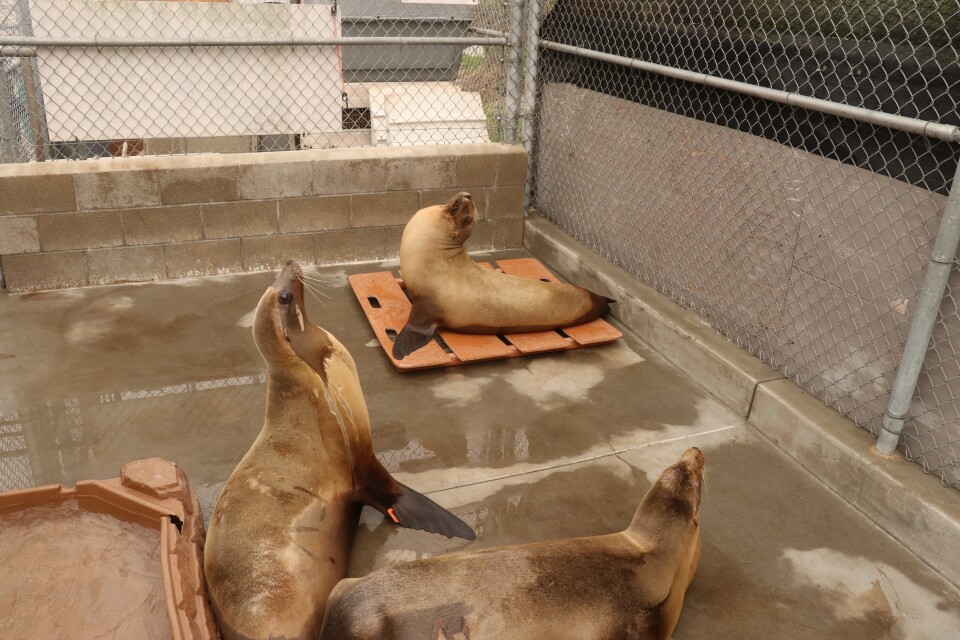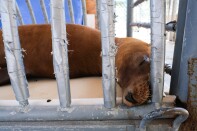With our free press under threat and federal funding for public media gone, your support matters more than ever. Help keep the LAist newsroom strong, become a monthly member or increase your support today.
Sick sea lions are coming ashore in Malibu. What’s going on?

Dozens of sea lions have shown up sick on L.A. County shores in the last week.
The mammals have signs of domoic acid toxicosis — that’s when algal blooms put out a harmful neurotoxin that can hurt sea life. Most of the sick mammals have come from Malibu, though they’ve been seen as far south as Redondo Beach.
At least five adult sea lions have died.
What we know
Though harmful to sea life, algal blooms are natural events that usually last four to eight weeks.
When some algal blooms grow out of control, they can emit a neurotoxin that accumulates in small fish, like sardines and anchovies. When sea lions eat those fish, the toxin binds to their brain and heart. They can have seizures, tremors, vision issues and even cardiac problems.
This is Southern California’s fourth year in a row seeing domoic acid blooms. Our largest event on record was in 2023 when more than 1,000 sea lions died. It can happen at any point in the year, but most blooms happen in spring or fall.
It’s still unclear how large this event could be. Dr. Michelle Rivard, Marine Mammal Care Center’s director of animal health in San Pedro, said what the center is seeing in sea lions indicates they were exposed recently.
“ They’re stranding in really good body conditions — the females are 180 to 200 lbs,” she said. “We’re seeing them either basically comatose, not responding appropriately to people, with seizures, tremors, things like that.”
Most of the sea lions in the center’s care are adults and pregnant. Infections can pass on to pups that are then born with neurological issues.
Marine Mammal Care Center is working alongside Malibu’s California Wildlife Center to gather reports and capture the mammals for treatment. However, some haven’t been caught yet because they’re in inaccessible areas.
Water temperature and other factors can influence harmful algae growth, though the process isn’t fully understood.
Did wildfires play a role?
Since most of the sick sea lions are showing up in Malibu, it’s not unreasonable to ask if runoff from the January fires is part of the equation.
“ While runoff is a small piece of the puzzle that can feed these blooms, we really don’t know enough at this point with this specific bloom to say that there’s any relation to the fires at all,” Rivard said.
John Warner, chief executive of the Marine Mammal Care Center, said runoff is a concern because it could contain things like building materials and batteries. But he said that those effects could show up in years — not weeks.
The center hasn’t yet confirmed it’s domoic acid, but Rivas said the sea lions are showing signs consistent with exposure to it. They’re awaiting sample tests to verify it as well as toxicology reports to check for other issues.
What you should do

Sick sea lions could show up anywhere on the coast. A few have been seen in Santa Monica, Playa del Rey and Ventura County.
Experts warn they can be unpredictable. They may move their head around in a motion known as “stargazing,” be aggressive to people, or appear lethargic or comatose.
If you see any stranded on the beach in distress, you should stay at least 50 feet away.
“ If they can respond to you, then you’re too close,” said Dave Bader, Marine Mammal Care Center’s chief operations and education officer.
To report sightings, call the Marine Mammal Care Center at (800) 39-WHALE. You can also contact the California Wildlife Center, which serves the Malibu area, through its marine mammal rescue hotline at (310) 924-7256.













